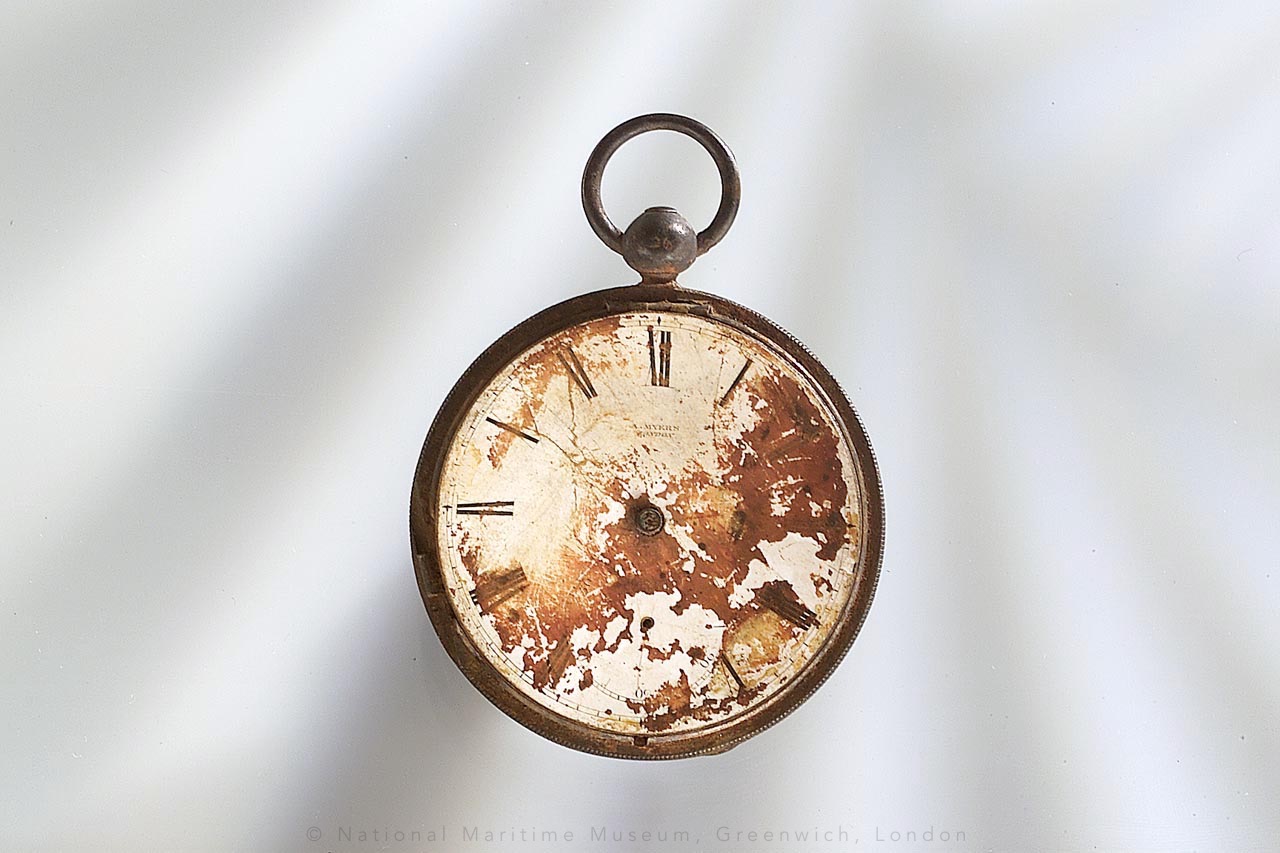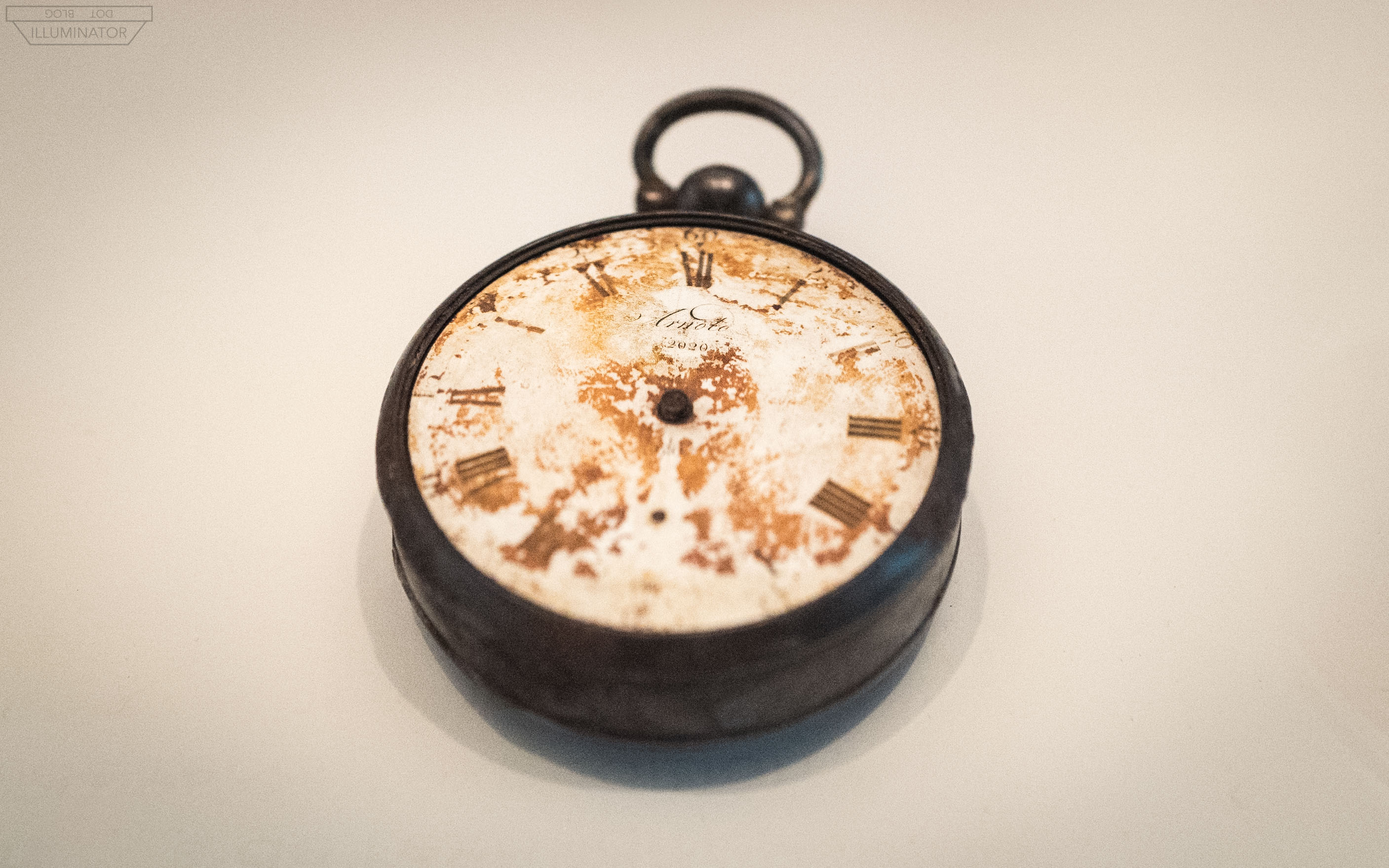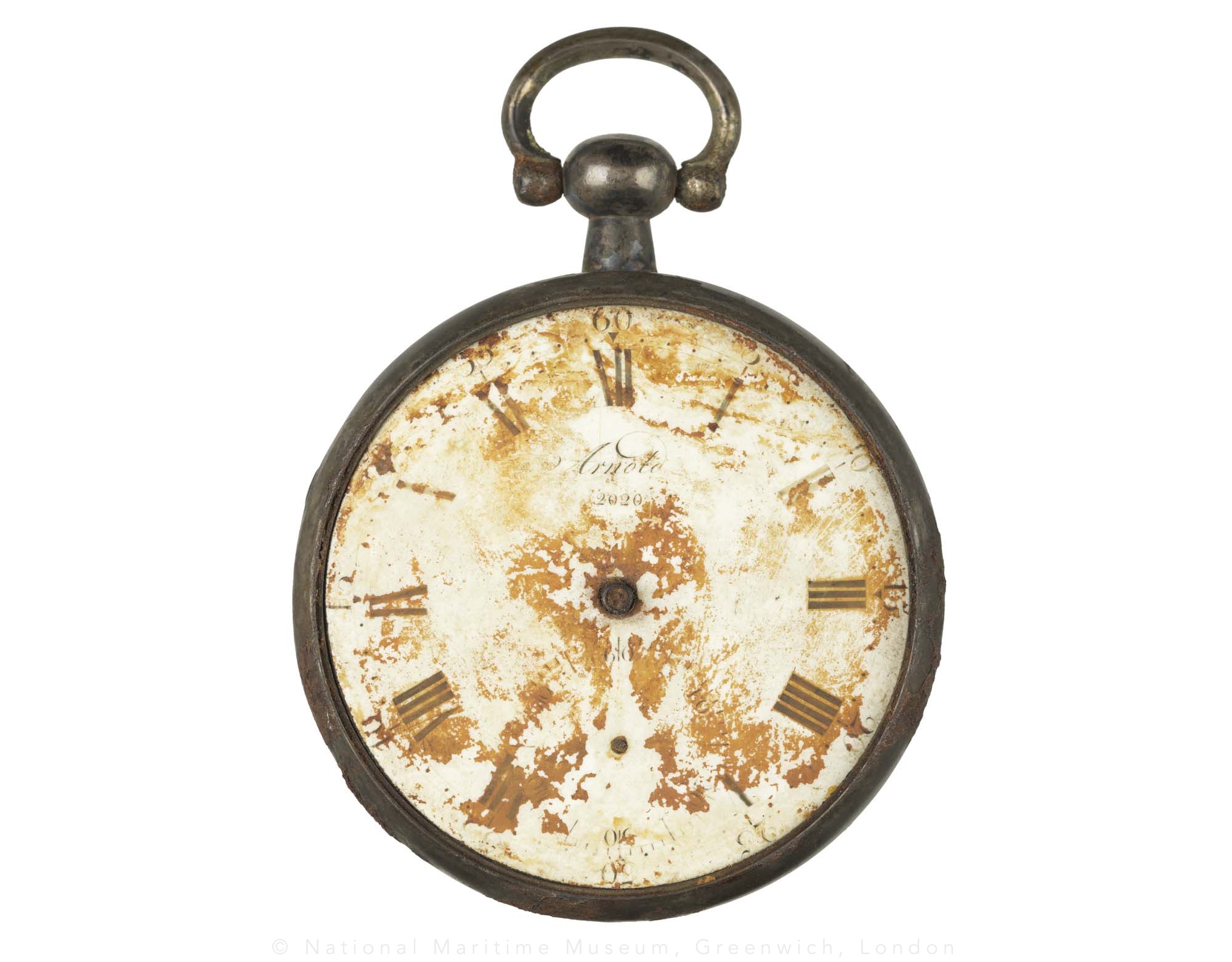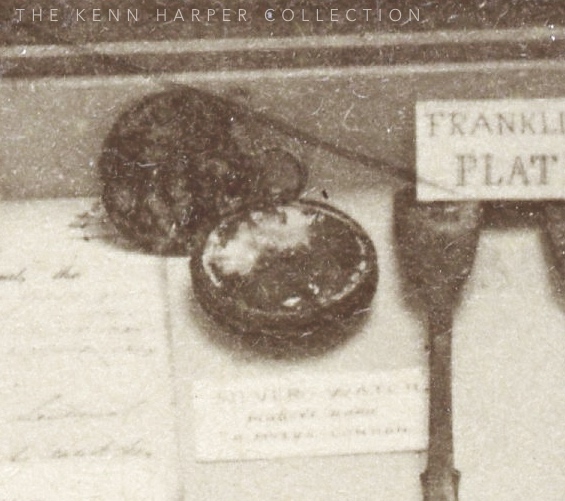By Logan Zachary. December 8th, 2021.
Acknowledgments:
Russell Taichman
Kenn Harper
& Alison Freebairn
Summary: An investigation of a pocketwatch suspected of being a Franklin relic.

{ The suspected Franklin relic: A. Myers London. }
Franklin researcher Russ Taichman recently forwarded me this image, which he ran across in a 2015 book by John Geiger & Alanna Mitchell. It shows a timepiece in the collection at Greenwich. Intriguingly, the book’s caption here says that this is, “…thought to be a relic of the Franklin expedition, but this is not certain.”
Taichman located the artifact on Greenwich’s relic pages. There the National Maritime Museum also describes it as a possible — but not confirmed — Franklin relic:
“This watch is believed to be one of the relics of Sir John Franklin’s ill-fated 1845 Arctic expedition.”
The name on the dial reads: A. MYERS LONDON.
There are no details given as to why the Myers watch is suspected of being a Franklin relic. But one possible motive is obvious at a glance.

{ Myers pocketwatch and Arnold 2020 chronometer. }
{ A suspected vs. confirmed Franklin relic. }
The staining on the Myers watch face bears a marked resemblance to the staining on the face of Arnold 2020, a Franklin Expedition chronometer recovered from the Boat Place.
The Erebus Bay Boat Place was first discovered by the McClintock search expedition in 1859. There is, however, no mention of a Myers watch in The Voyage of the Fox, Captain McClintock’s expedition book. Nor is there a Myers watch mentioned in the report by Lieutenant Hobson, the sledge team leader who first discovered and collected relics from the Boat Place.
However, I have found mention of a Myers watch connected to Franklin: in newspaper reports of the 1859 Franklin relics exhibition, held upon the return of the McClintock search. This would support a potential Boat Place connection.
From a review of that exhibition prior to its opening:
There are also various articles of plate, the greater portion of which is marked with Sir John Franklin’s device, and two pocket chronometers in excellent preservation. A small silver watch, maker’s name, “A. Myers, London,” probably belonged to some young mate or midshipman…[The Daily News (London), 17 October 1859.]
That name is a match: A. MYERS LONDON.
The first sentence also mentions two chronometers along with plate (i.e., silverware). That description resembles case #8 from the 1859 exhibition. As the Myers watch is mentioned immediately after the two chronometers — and, being a timepiece — it is highly likely that the Myers watch would be in that same case with the chronometers.
And of course, we can still see that case. The relics exhibition cases were photographed at the RUSI Museum by Franklin searcher John Powles Cheyne — in stereography (twinned images for 3D viewing).

{ John Powles Cheyne’s stereograph of case #8. }
{ Image courtesy Kenn Harper. }
The two big chronometers are in the upper left. Nearby are pieces of broken pocketwatches found in the boat. If the Myers watch is indeed a Boat Place relic, it would be here.

{ Timepieces in Cheyne’s stereograph. }
The Myers watch at Greenwich has a very distinct feature: a ring on top. Amongst the pocketwatch pieces seen in Cheyne’s stereograph, we can eliminate several pieces which lack this feature.

{ The Myers pocketwatch, with ring on top. }

{ The two pocketwatches with rings in case #8. }

{ Detail of the two pocketwatches with rings. }
There are only two pocketwatch pieces in Cheyne’s stereograph with a ring on top.
The righthand watch we can seemingly eliminate at a glance. It is very dirty, the dial almost completely obscured by filth. After 10 years’ exposure in an open boat, this is unsurprising. But this watch dial is far more stained than the Myers watch — or Arnold 2020, which we saw at the beginning of this article. This is too dirty to be the Myers watch.
Unless, perhaps, that rightmost pocketwatch was cleaned at some point.
But if it was cleaned, how would we know? And how would we match a dirty watch face to a now cleaned watch face?
* * *
There’s one issue with Cheyne’s case #8 stereograph that has bothered me since this series began: Arnold 2020 is upside-down.

{ Chronometer Arnold 2020 in Cheyne’s stereograph. }
Arnold 2020 is a very attractive Franklin relic. Not in spite of the staining on its dial, but because of it. There are many other fine old chronometers in the collection at Greenwich, their dials white as snow and their metal polished to a mirror shine. Arnold 2020 is a ruined wreck. But as a wreck, it tells part of the larger story of the lost expedition, showing us a glimpse of the scene at Erebus Bay. No amount of anonymous cleanliness could ever be this evocative.

{ Arnold 2020, photographed by author. }
So why would anyone turn this piece face-down?
What if Arnold 2020 had originally been dirtier? Perhaps Arnold 2020 was displayed face-down in 1859 because her dial was then completely obscured by filth. There would be nothing to see on the front. And then her shiny back would be more interesting to show the public than an unrecognizable front.

{ Chronometer Arnold 2020. }
And there is indeed some evidence of cleaning on Arnold 2020’s face. Around the numerals II, III, and IIII, there are visible scratches through the dial’s stain. Equally telling is that: even in this cleaned area, the staining has held fast between the letters of the III and the IIII, doubtlessly protected by the slight ridge of the letters.
If Arnold 2020’s dial was cleaned at some point post-1859, then it’s likely that that dirty rightmost pocketwatch was cleaned at the same time.
* * *
For this series of articles on Cheyne’s stereography, Kenn Harper allowed me to study his set of Cheyne’s Franklin stereographs. The high quality of Harper’s set allows us to read some of the notecards from the 1859 exhibition.

{ The notecard beneath the rightmost watch. }
The rightmost watch’s notecard certainly begins with, “SILVER WATCH.”
The 2nd line is indistinct. But the bottom line perhaps might be read as, “A MYERS LONDON.” Certainly the last word looks like London; the other letters resemble a single initial followed by a word starting with “M…”
As well, the exact line in the newspaper report had read:
A small silver watch, maker’s name, “A. Myers, London,” probably belonged to some young mate or midshipman...
The newspaper reporter would likely have read such detailed information right off the display case. And one way to read the notecard at the museum, then, is that it may be the newspaper report’s first words precisely:

{ Newspaper text compared to the museum notecard. }
As such, “maker’s name” looks to be a very plausible fit for the indistinct 2nd line of the notecard.
This brings us very close to a definitive identification. I also tried comparative measuring, using the sizes listed on Greenwich’s website; the rightmost watch’s size relative to the chronometers roughly fits this (i.e., almost as wide, not nearly as thick), and therefore also suggests that it may be the Myers watch.
However, I believe the staining will prove a definitive identification.
This is because, despite the later cleaning, a stain might be thought of as a fingerprint. Even if most of it is erased, what remains can still act as a signature to be identified.

{ The Myers watch annotated by stain areas. }
A distinct feature of the Myers watch is that: the staining on the northwest half has a different appearance than the southeast half. Both have clean zones and stained zones, but they differ markedly in appearance. The northwest half shows gradual transitions from dirty to clean, whereas the southeast half shows very abrupt transitions. That southeast half does not look like a natural distribution of dirt: it looks like the dirt was chipped away. As well, the clean zones of the southeast half are whiter than the dial appears anywhere else, further suggesting it was chipped clean.
This would correlate strongly to what we saw on the rightmost watch in Cheyne’s stereograph: it was the southeast half that was very dirty. The northwest half was already relatively clean — indeed, it looks clean enough that numerals IX through XII are discernible.

{ The rightmost pocketwatch in case #8. }
This cleaner northwest half, then, allows us to make an identification. As the area less in need of a cleaning, it would be less changed since 1859.
If we roughly trace the edges of the northwest clean area on the Myers watch at Greenwich, we see a distinct shape emerge.

{ The Myers watch annotated with stain lines. }
Everything between these two black lines is clean.
We can then make a similar tracing of the original clean area on the watch in Cheyne’s stereograph.

{ Both watches annotated with stain lines. }
The resulting shapes are near-identical.
An easier way to visualize this: the upper and lower boundary lines create a signature of the clean area from each watch.

{ The stain “signatures” from each watch. }
The “signatures” created by the stain lines are a match. These two must be the same watch. The rightmost pocketwatch in Cheyne’s stereograph — the very dirty pocketwatch with a notecard ending with “…LONDON” — must be Greenwich’s suspected Franklin relic, the heavily stained pocketwatch by, “A. Myers London.”

{ A. Myers London: a Boat Place relic. }
I sent this provenance change recommendation to Greenwich’s Curator of Polar Relics on August 29th, to confirm this artifact #JEW0030 as a Franklin relic, originating from the Boat Place on Erebus Bay, recovered by Lieutenant Hobson.
This is the 8th change of provenance recommendation for a Franklin relic resulting from this study of John Powles Cheyne’s stereography.
The End.
– L.Z. December 8th, 2021.
* * *
Appendix 1: Additional notes.
In the week after writing this recommendation, I came across two further mentions of the Myers pocketwatch relic.
One is in the handwritten draft of the 1913 Royal Naval Museum Catalogue, held at Greenwich (NMM 20/3). In that catalogue, case #13 item #8 is listed as: “Silver Watch Maker Name, A. Mayers London.” This particular wording must be an echo of the original notecard from the 1859 exhibition.
The other mention is in McClintock’s notebook from the Fox expedition, also held at Greenwich (MCL 21), in a handwritten list of relics therein. Under the heading “Relics found by Lieut Hobson” and “From the Boat,” McClintock lists: “A large silver watch, maker A. Myers, London. the glass [indistinct] replaced by a silver plate.” Incidentally, that McClintock described this pocketwatch as “large” here is a final bit of confirmation that the Myers watch is indeed the largest of the three Boat Place pocketwatches in Cheyne’s stereograph (he does not use that adjective when listing the other two).
Appendix 2: Bibliography.
Geiger, J., & Mitchell, A. 2015. Franklin’s Lost Ship: The Historic Discovery of HMS Erebus.
This is the book mentioned at the outset of this article, where Russ Taichman first noticed the Myers watch. I omitted naming the book then, as its title could mislead readers into assuming the Myers watch had been recovered from HMS Erebus. In fact the watch appears in a section covering the early Victorian searches (Chapter 6, page 131).
McClintock, F. Leopold. 1859. The Voyage of the Fox in the Arctic Seas.
Stenton, Douglas R. 2014. "A Most Inhospitable Coast: The Report of Lieutenant William Hobson’s 1859 Search for the Franklin Expedition on King William Island." Arctic, Vol. 67, No. 4 (Dec 2014) p. 511-22 (link).
“The Franklin Relics.” The Daily News (London), 17 October 1859, p. 3.
Links to artifact pages at Greenwich’s site:
A. Myers London pocketwatch. JEW0030 (link).
Arnold 2020 chronometer. AAA2202 (link).
* * *
This is Part 8 in a series revolving around Cheyne's relic photography.
- Part 1: The Missing Toy Sledge from Erebus
- Part 2: Cheyne's Motion Pictures
- Part 3: Cheyne's Relics
- Part 4: Lost Letters of the Victory Point Record
- Part 5: Where The Fox Docked
- Part 6: Who Was Photographed With The Fox?
- Part 7: Reversing the Chronometers at the Boat Place
- Part 8: A Stained London Pocketwatch
- Part 9: (forthcoming)
– L.Z. December 8th, 2021.
